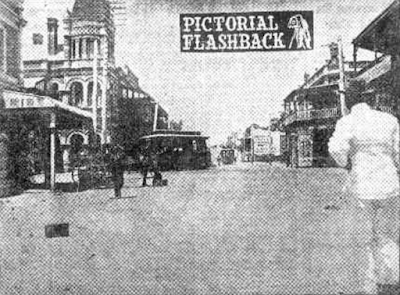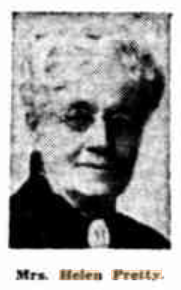Subiaco Centenary Celebrations And The Acknowledgement Of Women... (1929).
In April, 1929 Subiaco had special celebrations to commemorate the centenary of Western Australia .
In the past many histories have focused on the achievements of prominent men. They have excluded the contributions made by Indigenous peoples, women, migrants and children.
The article titled 'Subiaco Celebrations' published in the West Australian in 1929, fully acknowledges the contribution made by women and the hardships they endured while living in Subiaco during the early years. The article states "Mr. W. Richardson, M.L.A., who said that any success "that had come to the municipality, was due to the women. In the early days they had endured many hardships."
The article is from Trove, the database of the National Library of Australia. No copyright infringement intended.
The article and photograph of school children participating in the centenary is from Trove, the database of the National Library of Australia. No copyright infringement intended.
West Australian, 17 April 1929.
SUBIACO CELEBRATIONS.
Pioneers' Re-union.
To commemorate the centenary of Western Australia the residents of Subiaco are holding special reunions and celebrations throughout the present week.
The celebrations commenced officially last night when 300 pioneers of the district attended a re-union in the King's Hall. Subiaco. The Mayor (Mr. J. C. Roydhouse), in welcoming the pioneers, referred to the 'Back to Subiaco Week' as part of the Centenary celebrations.
He outlined the progress of the municipality, stating that originally it consisted solely of hessian houses. Today, there are many fine buildings, while the population had grown to 17,000.
He was supported by Mr. W. Richardson, M.L.A., who said that any success 'that had come to the municipality, was due to the women. In the early days they had endured many hardships.
Many of the pioneers responded, including ex-Councillor J. Delamare, and the first stationmaster of Subiaco, Mr. E. G. Paddison. The latter stated that the revenue in May, 1906 from passengers' fares from Subiaco was £3/15/, and from goods traffic £31. In 1905 when he left the station the revenue was £12,000.
The programme for the remainder or the celebrations is as follows: - Today, cricket reunion: tomorrow, Bowling Club reunion: Friday, Choral Society concert; Saturday, gala and procession; Monday, footballers' reunion; Tuesday, Centennial Ball: The profits from the gala arid the ball will be donated to the Children's Hospital. Sunday has been dedicated to citizenship. Special services will be observed in all churches.
In the afternoon there will be a united citizens' gathering in West's Theatre.
West Australian, 30 September 1929.
CHILDREN'S DISPLAY.
Thousands in Drills and Dances.
In perfect weather, 7,000 State school children took part in a display at Perth Oval on Saturday afternoon, in the pre-sence of a large crowd. At 2.30 p.m., when the display was timed to begin, hundreds of people were still clamouring at the gates for admittance, and the ground and the grandstand were crowded. The arrangements were in the hands of Acting-Chief Inspector of Schools (Mr. J. A. Klein), the
SPECTACULAR DEMONSTRATION BY SCHOOL CHILDREN TO MARK THE CENTENARY.
About 7,000 children from metropolitan schools gave a massed display at Perth Oval on Saturday. The maypole dance was one of the most spectacular events.
Director of Physical Culture (Mr. R. Blair) and Miss. Emily Ware. The chief marshals were:— Boys, Messrs. R. Llewellyn (Subiaco), E. Smith (North Perth), and C. Lutz (Mount Hawthorn); girls, Messrs. G. W. Bailey (East Victoria Park), A. Lasscock (West Leederville), and J. Lunt (Rosalie).
A large number of other helpers, members of the staff of the Education Department, gave up their Saturday afternoon in order to contribute to the success of one of the most charming and impressive features of the centenary celebrations. Appropriately, the display began with a march of white-clad little children to position beneath a number of maypoles, the particoloured streamers of which hung down invitingly. They were not to be used yet, however, and the children merely joined hands and danced around the poles to a lively tune from the band.
The dance chosen was the old-fashioned Sir Roger de Coverley, and it was danced with charming abandon. Next came a spectacle which must have constricted many throats and dimmed many eyes, so inspiring, it was and so pregnant with glimpsed implications. The new generation of West Australians marched on to the ground in their thousands, heads up and eyes shining, carrying themselves with conscious pride. The boys turned to the left as they entered the arena; the girls to the right. Opposite the grandstand the coloums of fours met and crossed, the white-shoe feet and striking coloured head dresses of the girls making a kaleidoscopic pattern behind the ranks of proudly marching boys.
The boys were uniformly dressed in white shirts, navy blue pants, socks, and, white sand-shoes. The girls were in white silk jumpers and black skirts, but one third had brilliant yellow head-dresses and ties, another third brilliant blue, and another red. Applause which sounded like a rainstorm greeted the marching thousands. The grand march over, the turn of the little children came, and maypole dancing delighted the spectators for 20 minutes. Flying feet, and flying curls danced merrily among the coloured streamers.
Next, a squad of sturdy boys marched on to the ground and formed on their markers with the precision of a Guards battalion. Each boy carried a red flag and a white one. A series of exercises, to which the coloured flags gave brightness, followed. In the next item, the senior girls went through a programme of physical drill, rhythmic exercises, folk dances, and marching. Their dancing of a sailors' hornpipe brought a storm of applause. Physical exercises by a large squad of senior boys closed the afternoon s display.






















